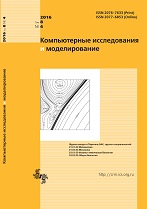|
MODELS IN PHYSICS AND TECHNOLOGY
Perspectives of using a satellite imagery data for prediction of heavy metals contamination
A. V. Uzhinskiya, G. A. Ososkova, P. V. Goncharovb, M. V. Frontasievac
a Joint institute for nuclear researches, Laboratory of Information Technologies,
6 Joliot-Curie st., Moscow reg., Dubna, 141980, Russia
b Sukhoi State Technical University of Gomel,
48 Prospect Octiabria, Gomel, 246746, Republic of Belarus
c Joint institute for nuclear researches, Frank Laboratory of Neutron Physics,
6 Joliot-Curie st., Moscow reg., Dubna, 141980, Russia
Abstract:
Air pollution has a significant impact on the European and Asian countries. The aim of the UNECE International Cooperative Program (ICP) Vegetation in the framework of the United Nations Convention on Long-Range Transboundary Air Pollution (CLRTAP) is to identify the main polluted areas of Europe, produce regional maps and further develop the understanding of the long-range transboundary pollution. Specialists of the Joint Institute of Nuclear Research (JINR) developed cloud platform (ICP Vegetation Data Management System, DMS) consists of a set of interconnected services. The platform intended to provide ICP Vegetation participants with modern unified system of collecting, analyzing and processing of biological monitoring data. More than 6000 sampling sites from 40 regions of different countries presented at the DMS now.
Modeling of areas where sampling carried out rarely or where dimension of the sampling grid is rather big is an important stage of the environmental monitoring. Using of the special statistical models and machine learning technics together with different parameters and information about concentrations from the sampling sites is one of the perspective approaches for prediction. The most perspective source of the additional parameters for the models is satellite imaginaries done in different specters. Specially trained model taking into account also parameters from the satellite images can predict concentration. Google Earth Engine platform is an innovating tool for search and processing GIS-data from different sources. There are more than 100 satellite programs and modeled datasets. Google Earth Engine has JavaScript online editor to create and verify code and python API to communicate with users applications.
Possibilities to predict a heavy metals concentration by a special statistical models and machine learning algorithms are considered. Sources for model training are satellite imagery from Google Earth Engine platform and sampling data from DMS for ICP Vegetation program.
Keywords:
prediction, ecological monitoring, satellite images, machine learning.
Received: 28.03.2018
Revised: 07.05.2018
Accepted: 10.05.2018
Citation:
A. V. Uzhinskiy, G. A. Ososkov, P. V. Goncharov, M. V. Frontasieva, “Perspectives of using a satellite imagery data for prediction of heavy metals contamination”, Computer Research and Modeling, 10:4 (2018), 535–544
Linking options:
https://www.mathnet.ru/eng/crm463 https://www.mathnet.ru/eng/crm/v10/i4/p535
|

| Statistics & downloads: |
| Abstract page: | 282 | | Full-text PDF : | 98 | | References: | 38 |
|



 Contact us:
Contact us: Terms of Use
Terms of Use
 Registration to the website
Registration to the website Logotypes
Logotypes